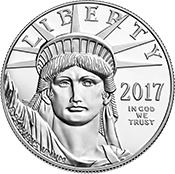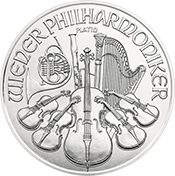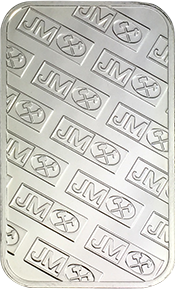What is Platinum?
Platinum is one of the rarest metals found on earth—even though it’s plentiful on the moon! This shimmering metal is even more “precious” than gold and silver. It’s estimated that all the platinum in the world could fit into a 20-foot-square cube.
Platinum is one of the purest metals on earth, and possesses some extremely valuable qualities:
- Higher ductility than gold, silver and copper
- Extremely malleable
- High resistance to tarnish and corrosion
- Highly unreactive
- Heavier than gold and silver
Platinum occurs on the periodic table with symbol Pt and atomic number 78.
While indigenous peoples in different parts of the world may have used platinum for centuries as jewelry and decoration, Antonio de Ulloa is credited as the first Western European to officially discover the precious metal in 1735 in South America. The word “platinum” comes from the Spanish word “platina,” meaning “little silver.” Early Europeans also called the metal “white gold” because they weren’t quite sure what it was.
Scientific experiments beginning in the 18th century have led to our current understanding of the precious metal’s valuable properties. In WWII, platinum was banned for use by the public and relegated to strictly military purposes. After the war ended and restrictions were lifted, the demand for platinum has been on the rise in the investment community.
Read more: History of Platinum as a Precious Metals Investment
How Are Platinum Spot Prices Determined Today?
The platinum spot price is calculated very similarly to gold spot price and silver spot price, updated on the minute during open market hours. The spot price is the price available for delivery now, while futures contracts are calculated for future delivery.
Platinum spot prices are primarily determined on the NYMEX and COMEX exchanges. The London, Zurich, Chicago, China, and Hong Kong exchanges also influence the spot price of platinum.
Platinum is an extremely rare metal with high liquidity, a fair amount of short-term volatility, and a track record of proven long-term security, making platinum both an exciting and profitable investment. A variety of industries affect overall platinum demand:
Jewelry
Platinum is renowned for its striking application in specialty jewelry. More than 50% of platinum is used in jewelry, so the price of platinum can be affected by changing consumer trends and demands, such as platinum becoming more fashionable.

Automobile Manufacturing
Platinum is the “greenest” of all the metals. Since the 1970s, the automobile industry has used platinum in catalytic converters to break down air pollutants. Platinum increases energy efficiency in fuel cells. Changing environmental regulations could affect the platinum price as the world “goes green,” and the automobile field accounts for a large portion of platinum demand.

Medical Applications
The medical industry uses platinum for a variety of purposes, including chemotherapy, pacemakers and stents. Further research and development could create greater demand for platinum.

Electronics
Platinum plays some role in electronic devices like thermometers and electrodes, which contributes to overall industrial demand for platinum.

Other Factors That Influence Platinum Spot Prices
As demand for platinum increases, the supply also decreases, making this already rare metal even scarcer:
- Most platinum is mined in South Africa, where political instability such as mining strikes and economic downturns may affect production and therefore the availability of supply.
- Market forces, such as investor demand, government policies, interest rates, inflation and deflation can affect the price of platinum.
- As a precious metal with safe haven appeal, platinum prices can be affected by world events and economic instability, much like gold and silver.
Where could platinum prices be headed in 2019? Read: Platinum Price Forecasts 2019
Is Platinum a Good Investment?
Considering the growing demand for platinum in jewelry, automobiles, medicine, and electronics, as well as the increasing interest from investors and numismatics, combined with a limited supply of this finite resource, platinum presents a unique opportunity for long-term portfolio growth.
The market for platinum is currently smaller than gold and silver, meaning there may be less liquidity but also more specialized demand. As with any precious metals investment, there is always some risk involved, but the combination of heightened demand and limited supply, as well as the safe haven qualities inherent in precious metals, makes platinum a precious metal worth considering in any investment portfolio. Platinum makes a great addition to any numismatic portfolio with high-quality investment coins such as the well-loved Platinum Eagle. Some platinum coins and bars are also eligible for inclusion in a precious metals IRA.
Why Buy Platinum?
While gold and silver are well-known precious metals with universal appeal and high demand, platinum is one of the rarest and most exciting precious metals investments. Platinum’s metallic and electrical properties make it highly desirable in commercial and industrial applications. The metal’s beautiful aesthetic and rarity also makes it a coveted addition to investment coin collections, as well as greatly prized in fine jewelry.
Interest in platinum has been steadily increasing over the years, indicating a growing demand, while supplies are still relatively limited—platinum exists in lower quantities than gold and silver in the earth’s crust, and the amount of platinum regularly mined is only as a tiny fraction of gold and silver.
How to Buy Platinum
Platinum can be bought and sold in similar ways to other precious metals like gold and silver.
You can buy and store physical platinum:
- Platinum bullion bars
- Platinum bullion rounds
- Platinum bullion coins or proof coins
You can buy and trade platinum on the market without physical storage:
- Platinum mining stocks
- Platinum ETFs
- Platinum futures contracts



